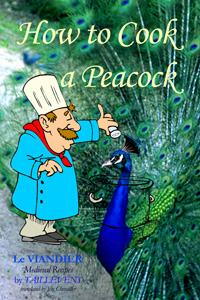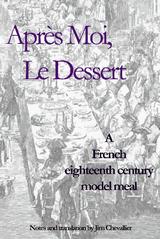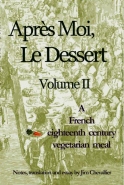CHEZ JIM
BOOKS |
August Zang How Viennoiserie Came to France
|

|
Once it was called "the Bond Street of Paris".
The steam oven transformed French baking.
Those beautiful 19th century Parisian bakeries have a Viennese pedigree. |
To order the book, click HERE. Back to main Zang page.
About the second edition
|
The second edition puts Zang's bakery in context, giving a glimpse of the exciting atmosphere of the then trendy rue de Richelieu and of Zang's address in particular. The look at Zang's innovations has been expanded to give a better idea of how French use of steam to glaze the bread grew out of Zang's introduction of this technique, and to cover other points as well, including the use of yeast and the poolish. A section on "Elegance and Upgrades" explores the changes in shops in general and bakeries in particular - the latter largely influenced by the "splendid" decor of Zang's Viennese bakery. The section on the baguette and the modern croissant have been updated to include new research, as has the section on Zang's role in the Viennese press. The new edition also includes some references to Zang from the American press and an expanded look at his successors in Paris. |
The rue de Richelieu in the nineteenth centuryToday, the rue de Richelieu is not a street most tourists notice, but in the nineteenth century the street where Zang started his bakery was the place to be. Here every thing savored of the fashionable world. Shops of a more respectable description richly decorated; goods of the most costly kind arranged for display with a very superior degree of taste and even elegance. Numerous equipages with liveried attendants driving about or waiting at the doors. Numberless loungers sauntering up and down...Decades later, Balzac (who kept a room on the street, above a fashionable tailor) praised the street: It is a golden dream and an irresistible distraction. One is at the same time alone and in company. The engravings of the print sellers, the day's shows, the treats at the cafés, the brilliants of the jewelers, all this makes you drunk and over-excites you. All of Paris' upscale and fine merchandise is there: jewels, cloths, engravings, books...Other writers, including Dumas, wrote about the neighborhood beauties (some more honorably employed than others). Jules Janin was particularly taken by the street's maids: These are for the most part (I speak of the soubrettes of the rue de Richelieu) young and pretty women, with white skin, pink cheeks, a fine bust, a provocative glance, a well-turned ankle. There is a whole future of three years of love in these young and pretty slaves of Parisian coquetry. ...Then there were Zang's future competitors. The gourmet Brillat-Savarin - who died before Zang's arrival - praised one of the prominent bakeries in the area: M. Limet, rue de Richelieu: he is the baker of HRH the duke d'Orléans and of the prince de Condé; I have adopted him because he is my neighbor, and I keep him because I have proclaimed him the first bread-maker of the world....The new edition offers much more about this glittering, hedonistic part of nineteenth century Paris. |
The steam oven comes to ParisSeveral years after Zang's bakery opened, Payen described at length how Viennese bakers had discovered the usefulness of steam in creating a glazed crust. The new edition looks more closely at how the technique took hold in France, as reflected, for instance, in this contemporary quote: It is from Austrian baking that French baking has borrowed, for many years now, the oven called Viennese, which differs from the ordinary oven, notably by a smaller opening and by the tilt of the sole. These arrangements are intended to favor the action of the vapor which comes off the bread while cooking, and which greatly contributes to giving the crust an agreeable color. Yeast and the poolishVarious writers credit Zang with much more than bringing the croissant to Paris - among other things, some claim he brought the use of yeast and the poolish, a pre-ferment still used by modern bakers, to France. The first edition already addressed the use of yeast in France; the second edition expands on that subject, noting the English influence which joined the Viennese, as in this quote from 1871: In France today, the use of old leavens in making bread is falling more and more into disuse, and, in Paris at least, English style fermentation has greatly spread.... These new procedures have not only been applied to fancy breads, they have been introduced into the making of ordinary breads as well.The new content includes a look too at the sponge and the poolish (sometimes treated as one and the same) and claims by Raymond Calvel and others that Zang brought the poolish to France. |
The changing face of French bakeriesBefore Zang, French bakeries were rustic affairs, with thick bars bulging out to the streets and minimal decor. Today, the influence of the first Viennese Bakery in Paris can still be seen in the many lovely old nineteenth century-style bakeries with marble counters, old mosaics, brass and mirrors. Bakeries in middle class neighborhoods imitated the Viennese bakeries. The locales they occupied were too small, their clientèle too modest, to allow them, like their fortunate rivals, to put common bread in a back room and to have, for sales and display, a vast and rich store, glazed with mirrors, lined with mosaics with allegorical paintings on the ceiling and rich ornamentation in the panels. But with a few well-placed mirrors, counters and shelves of white marble, a few gilded strips applied on a base of white lead, black and white tiles, the owners of these bakeries obtained pseudo-Vienneses.And who now remembers the Viennese Bakery Bubble (as we might call it today)? When it was established that making fancy bread, added to the usual bread, was a source of profit for the baker of the better neighborhoods, a certain number of speculators bought bakery businesses in second-rate neighborhoods, spruced them up, and added Viennese production, busied themselves in giving these establishments a fictitious and so short-lived prosperity; then they profited from a favorable moment to sell the establishment at a large profit and start again elsewhere.The new edition includes this in a larger discussion of "Elegance and Upgrades" - the tendancy of nineteenth century French businesses to add a veneer of elegance to attract the new, upscale bourgeois consumer. |
All text and translations copyright 2009 Jim Chevallier.
Please do not reproduce or post elsewhere without prior permission.
Interested in historical cuisine? Here are three other books from Chez Jim:
|
Yes,
the French kings really did eat peacocks - and swans, and herons, and
blackbirds too. Taillevent, the cook who served two of them, not only cooked
these dishes, but left a book on how to do it. He called it Le Viandier.
In this new translation, it's called: How To
Cook A Peacock ·
For recreational
medievalists ·
For lovers of
culinary history ·
For students of
medieval life ·
For adventurous cooks
|
Have you ever wanted to make an eighteenth century meal? This book, starting with a menu from a classic French cookbook, tells you how. Even if you don't have a house full of servants and a kitchen with numerous hearths, you'll find enough original French eighteenth century recipes - newly translated - here to entertain a number of guests in true eighteenth century style. This collection includes recipes for game, veal, beef, chicken and various sauces, salads and other tasty items, worth making on their own or as part of a full, elegant period meal. |
The second volume in this series presents VEGETARIAN recipes from Old Regime France. No, it's not a modern gimmick - in Catholic France, meat was forbidden on some days, and so one of the choices was this "meal of roots"; including not only carrots, parsnips, beets, turnips, etc., but also lentils and peas, onions, artichokes and asparagus. This collection includes over 100 recipes for soups, stews, salads, sweets, even... mock fish, made from vegetables of every sort (and even a fish or two). |
UPDATED: October 6, 2009


